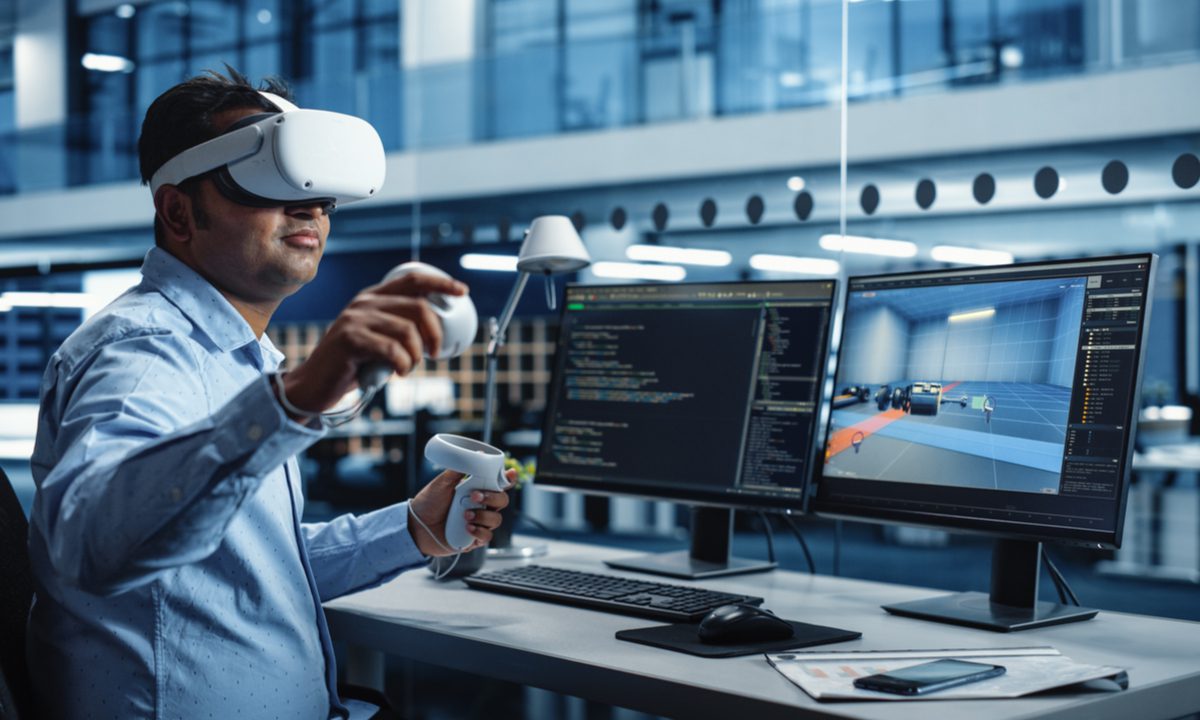AI Learning Turns Industrial Metaverses Into Digital Handymen

The digital twin of its 20,500 miles of tracks, signals and train stations German rail network Deutsche Bahn is building in an industrial metaverse uses a huge array of Internet-of-Things (IoT) sensors to let operators see what is happening in real time in a visually immersive virtual reality, so they can quickly fix problems that have dropped its on-time arrival record below 80%.
Which is nice.
But by adding in artificial intelligence, or AI, the national railway has a tool that can take the immutable record of all those signal glitches, congestion delays, weather incidents and figure out not just what happened, but also why it happened and how to prevent it in the future.
In this sixth article in the PYMNTS industrial metaverse series about the fledgling use of private enterprise virtual realities, we’ll look at the vital role AI plays in making these “digital twins” of breweries, mobile service providers, manufacturing facilities and even space rockets not only work better, but also learn how to work more efficiently.
See also: Is the Industrial Metaverse Virtual Reality’s Commercial Future?
Linking Digital Twins to Make an Industrial Metaverse
Interpol Now Trains Crimefighters in the Industrial Metaverse
German Railway Bets Industrial Metaverse Will Cut Delays and Boost Safety
Industrial Metaverses Are Useless Without IoT’s Real-Time Data
A digital twin can show you what’s going wrong in real time; AI can show you how to fix it. But it can also show you how to prevent it. And then it can learn how to make the whole system work better. An AI that’s watched a bottling line at one of Anheuser Busch InBev’s digitally twinned plants get snagged thousands of times can figure out why — a design flaw that can be fixed, or a more frequent inspection and maintenance schedule of specific parts of the machinery.
That said, it’s important not to underestimate the real-time aspect of AI’s role in an industrial metaverse.
The University of Houston’s College of Technology worked with the AI Consortium, industrial metaverse designer Nvidia, and other partners to bring digital twinning to its digital oilfield laboratory, David Crawley, a professor of practice at UH, explained in August.
You might also be interested in: Nvidia, Deloitte Beat Meta to Punch With Enterprise VR Offering
He gave the example of an oil drilling platform worker in the South Pacific using augmented reality headgear to have an engineer in Houston show him how to safely repair a piece of equipment without shutting down operations.
“In the metaverse, the AI technology invites an individual, anywhere, to put on a virtual reality headset and engage in an activity as if they were participating in the real world. Fixing a pipe, for instance, or identifying a problem in a valve,” said Crawley. That lets the worker see what he should be doing out on the platform, while leaving his hands free.
A Two-Way Street
But there’s another, symbiotic side to the relationship an industrial metaverse creates between AI and digital twins of a device, a facility or network of facilities.
“AI is ultimately the analysis of data and the insights we draw from it,” Lisa Seacat DeLuca, then a distinguished engineer and director of Emerging Solutions at IBM, told VentureBeat. “The digital twin provides a more effective way to monitor and share that data, which feeds into AI models. I boldly state that you can’t have AI without digital twins because they can bring users closer to their assets and enable them to draw better, more accurate and more useful insights.”
Which is to say, the network of IoT sensors and the object, facility or network being studies can be used to build a VR digital twin. But that digital twin and the data it produces can be used to improve the AI, not only by providing vastly more data points, but also a real-life representation of the entire system and how it works that the AI can use to run more effective simulations.
That means Deutsche Bahn can gather enough data so its AI can “not only [tell] us where we stand but [also] make predictions about the future and explore different scenarios,” Deutsche Bahn Chief Technology Innovation Officer Rolf Härdi said in a blog article.
He gives the example of “condition-based maintenance,” explaining that because he knows “exactly how the components and subsystems of a vehicle behave in every situation, how they change and how they wear out, I can then use the digital twin to perform predictive analyses and simulate maintenance scenarios.”
Add in other data that can be drawn from its IoT sensors, like the weather and speed at which a train runs, “we can draw conclusions and determine where we can improve. This increases the availability and profitability of our assets and therefore improves our service to customers.”
For all PYMNTS crypto coverage, subscribe to the daily Crypto Newsletter.
